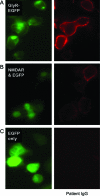Progressive encephalomyelitis with rigidity and myoclonus: glycine and NMDA receptor antibodies
- PMID: 21775733
- PMCID: PMC3146306
- DOI: 10.1212/WNL.0b013e318227b176
Progressive encephalomyelitis with rigidity and myoclonus: glycine and NMDA receptor antibodies
Abstract
Background: The syndrome of progressive encephalopathy with limb rigidity has been historically termed progressive encephalomyelitis with rigidity and myoclonus (PERM) or stiff-person syndrome plus.
Methods: The case is presented of a previously healthy 28-year-old man with a rapidly fatal form of PERM developing over 2 months.
Results: Serum antibodies to both NMDA receptors (NMDAR) and glycine receptors (GlyR) were detected postmortem, and examination of the brain confirmed an autoimmune encephalomyelitis, with particular involvement of hippocampal pyramidal and cerebellar Purkinje cells and relative sparing of the neocortex. No evidence for an underlying systemic neoplasm was found.
Conclusion: This case displayed not only the clinical features of PERM, previously associated with GlyR antibodies, but also some of the features associated with NMDAR antibodies. This unusual combination of antibodies may be responsible for the particularly progressive course and sudden death.
Figures


Comment in
-
Which pathomechanism damages the brain in antibody-associated CNS disease?Neurology. 2011 Aug 2;77(5):414-5. doi: 10.1212/WNL.0b013e318227b262. Epub 2011 Jul 20. Neurology. 2011. PMID: 21775740 No abstract available.
References
-
- Hutchinson M, Waters P, McHugh J, et al. Progressive encephalomyelitis, rigidity, and myoclonus: a novel glycine receptor antibody. Neurology 2008;71:1291–1292 - PubMed
-
- Moersch FP, Woltman HW. Progressive fluctuating muscular rigidity and spasm (“stiff-man” syndrome); report of a case and some observations in 13 other cases. Proc Staff Meet Mayo Clin 1956;31:421–427 - PubMed
-
- Whiteley AM, Swash M, Urich H. Progressive encephalomyelitis with rigidity. Brain 1976;99:27–42 - PubMed
-
- Brown P, Marsden CD. The stiff man and stiff man plus syndromes. J Neurol 1999;246:648–652 - PubMed
Publication types
MeSH terms
Substances
LinkOut - more resources
Full Text Sources
